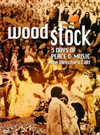|
|
||||
|
|
by Donald Levit  Later edited from "R" to "PG," Albert and David Maysles’ Gimme Shelter detailed the dark side, death at the Stones’ Satanic Majesties’ free 1969 “Woodstock West” at Altamont Speedway. That same year of 1970 saw In light of earlier disappointments with rockumentaries, Warner Brothers was reluctant to release this and refused to let it be any longer; ironically, while organizers lost their shirts, the studio made a pile on the film and three-record album. A hundred twenty hours of filming by thirteen cameramen (including the director) had been boiled down to four minutes over three hours for initial release. In 1994 an additional three-quarters of an hour’s footage was put back in for the video Saul Swimmer’s The Concert for Bangladesh came out two years later, made money from the Grammy-winning three-record set and, in an important point of comparison, was done with fixed cameras and thus recorded musician-participants while disregarding the Madison Square Garden audience and event ambience. Closer to Jazz on a Summer’s Day and Monterrey Pop, Then, too, such artsy lens stunts can detract from the excellently recorded sounds themselves. A convention by now, close-ups show the roof of a singer’s mouth, out-of-line upper canines, badly spaced teeth. For reasons serious or silly, some legends declined invitations, some accepted but backed out, while others did not want what they felt their inferior recorded performances included. The A-list who do appear are good, with some for the ages. More Jimi Hendrix was included in the video, maybe because his film-closing “Star Spangled Banner” is so standout and beautifully filmed, both his ecstatic concentration and brown hands against white guitar and grey sky. The film’s order appears purely chronological. Rushed into the opening slot when someone was snarled in traffic -- “The New York State Thruway is closed, far out!” exults helicoptered-in Arlo Guthrie -- Richie Havens finishes his appearance with a made-up-on-the-spot “Freedom.” Her voice no longer the early angel soprano, Joan Baez notes her six-month baby bump, talks about jailed husband David Harris, and sings two solos, and Joe Cocker spasmodically air-guitars his white Englishman’s blues. Thereafter the film abandons simple camerawork, unwittingly anticipating future concerts that were to be visual spectacle, sight over sound. Sha Na Na seems misplaced camp, and a last-minute John Sebastian rather lost, but most performances are stirring, with no identifying subtitles until end-credits. A very few are loudspeaker introduced, but the MoMA audience was overwhelmingly of that generation and knew its stars, anyway. Ten Years After, Canned Heat, the Who, Sly and the Family Stone, Santana, Country Joe and the Fish, pre-Starship Jefferson Airplane and Janis Joplin (the latter two not in the original commercial release). Some quarter of its time devoted to organizers Michael Lang and company, residents, tourists, gurus, vendors, portatoilet cleaners and, mostly, the hippie crowd, the film does better than Ang Lee’s lamentable Taking Woodstock in capturing what surrounded the music, which included three deaths, two births and four miscarriages. Dewy innocence and drugs describes the kids without tattoos or pierced body parts, although, with hindsight, the end of it all is apparent: there are no Latinos or Asian-Americans and only a sprinkling of African-Americans among these idealists who by and large could and would grow up to go back into the privilege from which they came. (Released by Warner Bros. Pictures; rated "R" by MPAA.) |
||
|
© 2025 - ReelTalk Movie Reviews Website designed by Dot Pitch Studios, LLC |



